Vegetable ragù, a pantry staple
I decided to open December not with a Christmas recipe, but with this smart pantry staple, a vegetable ragù that can save busy parents, but actually all busy human beings, at dinnertime.
Goodbye, November.
You have been tougher than I expected.
We worked on two recipes for Favuzzi: a roasted pork loin with apples, and a Tuscan schiacciata with green olive tapenade.
We closed the two intense and eye-opening months of a Personal Marketing Mentoring Program with Giulia Fiumi. It brought a deeper understanding of who we are, what we do, and why. This will shape our communication and our content from next year.
In the subscription-based newsletter, we shared recipes for Rice with butter, Parmigiano, and mozzarella, Chestnut risotto, Saltimbocca alla romana, and Focaccine with taleggio and mushrooms.
In October I had enthusiastically returned to the swimming pool after 18 months, then all of a sudden nasty viruses from the nursery school, family health issues, and deadlines stopped me again. Let’s keep our fingers crossed for a different December.
Welcome, December.
Get ready for Christmas: Home-made Advent Calendar, Holiday Gift Guide, Ten Course Menus for your Family, DIY foodie gifts, Cooking Marathons.
Just take a breath. Breath. It is not a marathon, not a race, nor a competition. It's just December. December is a month that has many reasons to be appreciated other than Christmas: the stillness of the open countryside, the most incredible colours I have ever seen in the nearby woods, the crates of oranges and clementines at the market, the avocados from Calabria and Sicily, new cookbooks to cook from, the detective stories I always feel attracted by in this time of the year. It is a game of darkness and light, a suspended time that has fascinated people since the beginning of times, a liminal space between two years, two worlds.
Don't get me wrong. This is not the Grinch speaking, I love Christmas. I love creating new family rituals, baking traditional treats, gift-wrapping with care even the most simple gifts, but I want to do it with my own timing, at my own pace.
This year more than ever I felt a social pressure to be performing, to be creative, and to share content, recipes, DIY ideas. Guess what? I'm going to ignore that pressure.
We haven't made an Advent Calendar for Livia. Our house is still in its everyday attire: cookbooks scattered everywhere, dogs carpets near the wood-burning stove, a few candles on my desk to keep me inspired when I write. I'm focused on December, living it day by day, eating an orange and drying its peel, and working frantically to close our cookbook manuscript before the end of the year: that is an actual marathon.
The key to surviving busy weeks like the ones we are living now is to lower the expectations, lower the pressure on what you should do, and give yourself small, manageable goals. Everything else you will get to realize, that will be an extra gift.
- Give Letters from Tuscany as a Holiday Gift! -
Are you searching for a sustainable and original gift for your loved ones? Don’t look any further! You can gift a subscription to Letters from Tuscany to your friend who wants to learn to cook, or to your daughter who’s missing Italy, or your mum, dad, aunt, brother, grandma… anyone interested in Italian food!
You can schedule your gift to arrive on the date you prefer, and you can even download a gift certificate.
Vegetable ragù, a pantry staple
That's why I decided to open the December month not with a Christmas recipe, but with this smart pantry staple, a vegetable ragù that can save busy parents, but actually all busy human beings, at dinnertime.
It is very similar to sugo finto, but it has inside more vegetables. Along with the trustworthy soffritto base - carrot, celery, onion, and garlic - I added the outer leaves of a Savoy cabbage, three stalks of broccoli, and the fibrous outer layers of two fennel bulbs: this vegetable ragù is also a virtuous way to upcycle kitchen scraps. Along with the fresh vegetables, I also added a jar of preserved sun-dried tomatoes, giving the sauce a meaty texture, providing it with the umami kick typical of a meat-based ragù.
I prepared it one night after dinner while trying to catch up with my to-do list at my computer: I do not recommend it. Instead, opt for a movie, some music, or a good book that will keep you company while the vegetable ragù will simmer away on the stove.
Head to the blog for the recipe, and notes on ingredients, variations, how to preserve it, and how to make a meal out of it.
12 recipes to cook this month
A creamy Jerusalem artichoke soup. This Jerusalem artichoke soup is a delicate winter soup with a gentle artichoke flavour. Top it with Jerusalem artichoke chips for a nice crunch, and a sprinkle of freshly ground black pepper.
Cocoa cappellacci with butternut squash. The fresh pasta is made with the addition of unsweetened cocoa powder, so simple to prepare yet so unusual: it has only a vague hint of cocoa, do not expect a chocolate fresh pasta, but it marries beautifully the sweet butternut squash filling, balancing it. The shape I chose is that of cappellacci, a stuffed pasta that resembles old-fashioned hats.
Bavarian bread soup. We could travel from North to South across Italy and find as many bread soups as there are gastronomic cultures, bread-making styles, and towns surrounded by more or less productive countryside. The same principle can be extended to other regions beyond the Alps, and brotsuppe, the Bavarian bread soup, is another fitting example. Brotsuppe is made with stale brown bread, meat stock, eggs, cream, and topped with fried bread croutons.
Gnocchi alla trabaccolara. Trabaccolara is a poor man’s dish, made with the demersal fish unsold at the market. This sauce traditionally accompanies large bowls of spaghetti or linguine, but you can also use hollow short rod pasta like paccheri or mezze maniche for a nice result: the flavours of the sea mixed with tomato fill up the pasta to a lovely effect. Today I used this dressing for fresh gnocchi.
Ricotta and kale gnudi. There are two crucial ingredients here that can help you ease the anxiety while waiting for your kale gnudi to float to the top: ricotta and cavolo nero, the Tuscan kale. Use well-drained ricotta and squeeze very well the cooked kale. Once you make this, they will be your next success in the kitchen.
Ossobuco, braised veal shank. I’ve always been intimidated by ossobuco because I thought it wasn’t easy to cook them and have soft, tender meat. But the secret is still the same, be patient, cook the ossobuco over a gentle heat for at least an hour and a half. The other trick is to cut the skin surrounding the meat, or remove it completely, to prevent it from curling during cooking.
Stewed Guinea fowl. Faraona in salmì, stewed guinea fowl, is a dish that has a strong sense of family, of festive days worth celebrating, a recipe whose aromas are very close to game meat, but that is at the same time accessible and easy to make.
Braised cabbage with sausages. The sausages here are not intended to merely add flavour or accompany bread, but rather play a more important role, similar to the beans in fagioli all’uccelletto. The tomato and chilli lend colour and a touch of sweetness. The cabbage is cut into thin strips and cooked very slowly over low heat, absorbing all the flavours that will delight your taste buds. Serve with fresh, crusty bread.
Cardoon flan. We have a fond preference for flans at Christmas, a festive side dish that plays its role next to more important main dishes and most of all can be made in advance, leaving the modern housewife free to entertain her guests while the flan is baking in the oven. In the now actual perspective of saving and recycling, the flan can be easily reheated in the evening along with other leftovers, the perfect meal to be eaten on the couch watching a Christmas movie.
Blood orange and fennel salad. A fennel and blood orange salad is my winter go-to side dish, especially when the main course is either grilled fish or pork chops. When I forget that I have a meal to prepare, though, this salad welcomes other ingredients and becomes a main.
Chocolate and clementine cake. It is an uncomplicated cake, comforting as a friend’s hug or a cup of tea in the afternoon. It has a soft and almost wet crumb, with a thin crisp crust. Look at it, it’s my cake. You can serve it with a dusting of icing sugar, which adds even more charm to its rustic look.
A quick zabaione to pick you up. Zabaione has such a long and fascinating story as it is made with ingredients that were easily available to families. It is relaxing and rewarding to make a zabaione, but it doesn’t even get close to the pleasure of sharing it with someone you love on a cold winter day.
Link Love
And now, a list of newsletters and articles I'm reading.
I'm really enjoying Dorie Greenspan's Newsletter, especially the "Making a Cookbook" series, where she introduces the talented professionals that worked with her to create her latest cookbook, Baking with Dorie. You'll meet Mary Dodd, her long time recipe tester, Mark Weinberg, the photographer, and Samantha Seneviratne, the food stylist.
Another favourite is Burnt Toast, by Virginia Sole-Smith, a twice-a-week newsletter about how we navigate diet culture and fatphobia, especially through parenting. It opens your mind to very delicate themes, debunks myths, makes you reflect, lights sparkles of hope.
Substack is heavily investing in food writing. They just launched 9 new food publications, by a group of writers that demonstrates the range and quality of food writing on Substack. It has become a full-time job to stay updated with all the amazing newsletters out there. As if that wasn't enough, they launched Ruth Reichl's month-long residency on Substack. How can I describe my excitement? It's like when you know you'll be receiving daily a letter written by one of your most loved food writers, a major source of inspiration, the extraordinary, multitalented, voraciously gourmandizing culinary poet otherwise known as Ruth Reichl, as Bill Buford perfectly describes her. It is going to be so much fun. This is the first issue.
How Marcella Hazan Became a Legend of Italian Cooking, from The New Yorker. I am guilty of never having looked deeply enough into the figure of Marcella Hazan and her role in sharing, teaching, and making accessible the true Italian cuisine in America. This article is an excellent starting point.
Are newsletters the future of food and recipe writing?
With the new year, we will focus even more on our newsletters. It is not a fad for us, as we’ve been writing newsletters for almost 10 years now. Now more than ever, though, we feel that newsletters are the way to go. We will still update regularly our blog, and you’ll find us on Social media, too, but our main content will be hosted by this newsletter you are reading. We are frankly tired of fighting with changing algorithms, technical issues, and media owned by big companies that decide who and when will enjoy your content.
We want a closer relationship with you, and we can get it here, as it used to happen in the heyday of blogs.
You subscribe to support the writers, bloggers, artists you love, and their thoughtfully crafted content lands in your inbox. We aim to have a conversation with real people, not to big numbers.
The newsletter will still be free, but there will be a paid version where we will share more exclusive recipes, stories, and video letters from the new year. Our readers and subscrivers grew in the past year, and for this we are incredibly grateful. We love to have you here, either you will subscribe to the paid newsletter or not, we love to hear from you in the comments, and when you hit reply to an email to share a glimpse of your life with us.
Let us hear your voice, what do you think of newsletters? Do you think they will be the future of food and recipe writing?
At the monthly cost ($5) of a gelato with double whipped cream, or at the annual cost ($40) of a good bottle of extra virgin olive oil, you can support our own independent publication directly.
When we first launched our subscription-based newsletter back in March, we thought it was mainly about sharing recipes. We could not believe it could become for you an anchor to Italy, to the Italian table and our loud conviviality, a reason to experiment with less known ingredients, the voice of a friend in the kitchen.
It is demanding to keep this newsletter active, interesting, and useful for you, on a twice a week basis and in two languages. For us it is like curating our own food magazine: we share seasonal recipes, essays, menu ideas, stories, ingredient insights, links, and travel tips. When you join Letters from Tuscany, you know you will receive twice a week some valuable content in your inbox, just like when your favourite food magazine is dropped at your doorstep.
What you missed recently: Rice with butter, Parmigiano, and mozzarella, Chestnut risotto, Saltimbocca alla romana, Focaccine with taleggio and mushrooms.
Whenever you decide to join us, you will have complete access to the whole archive of already published recipes and stories.
Thank you for reading! - Giulia and Tommaso





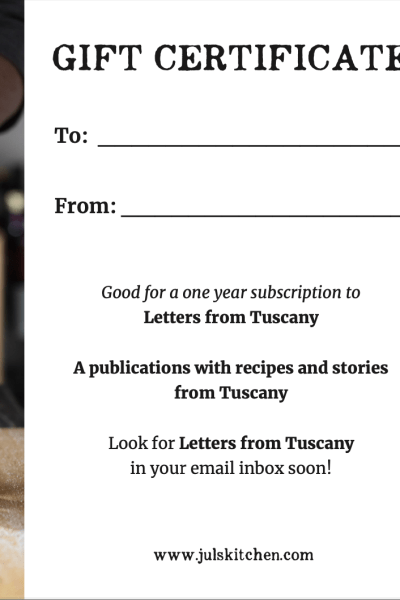
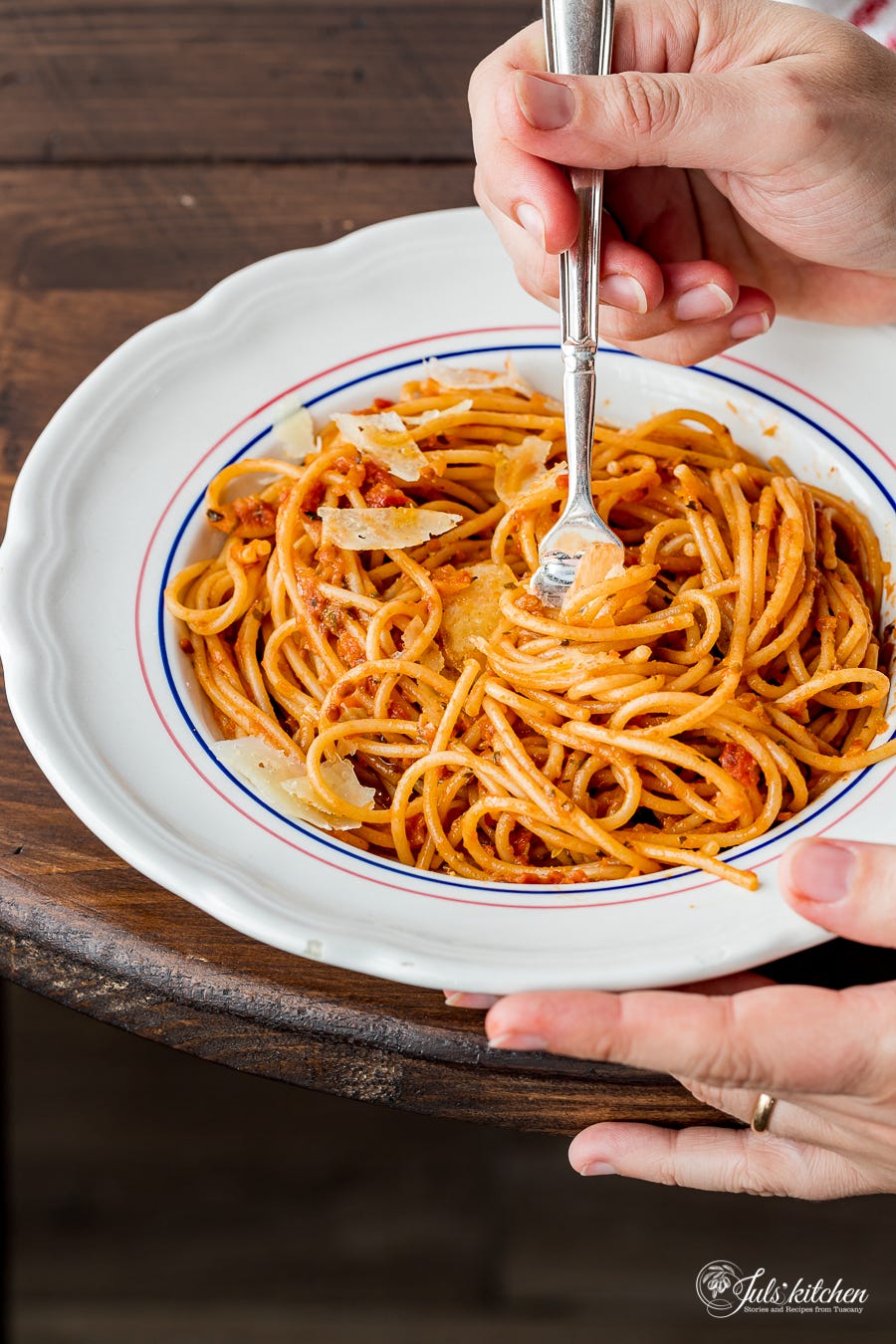
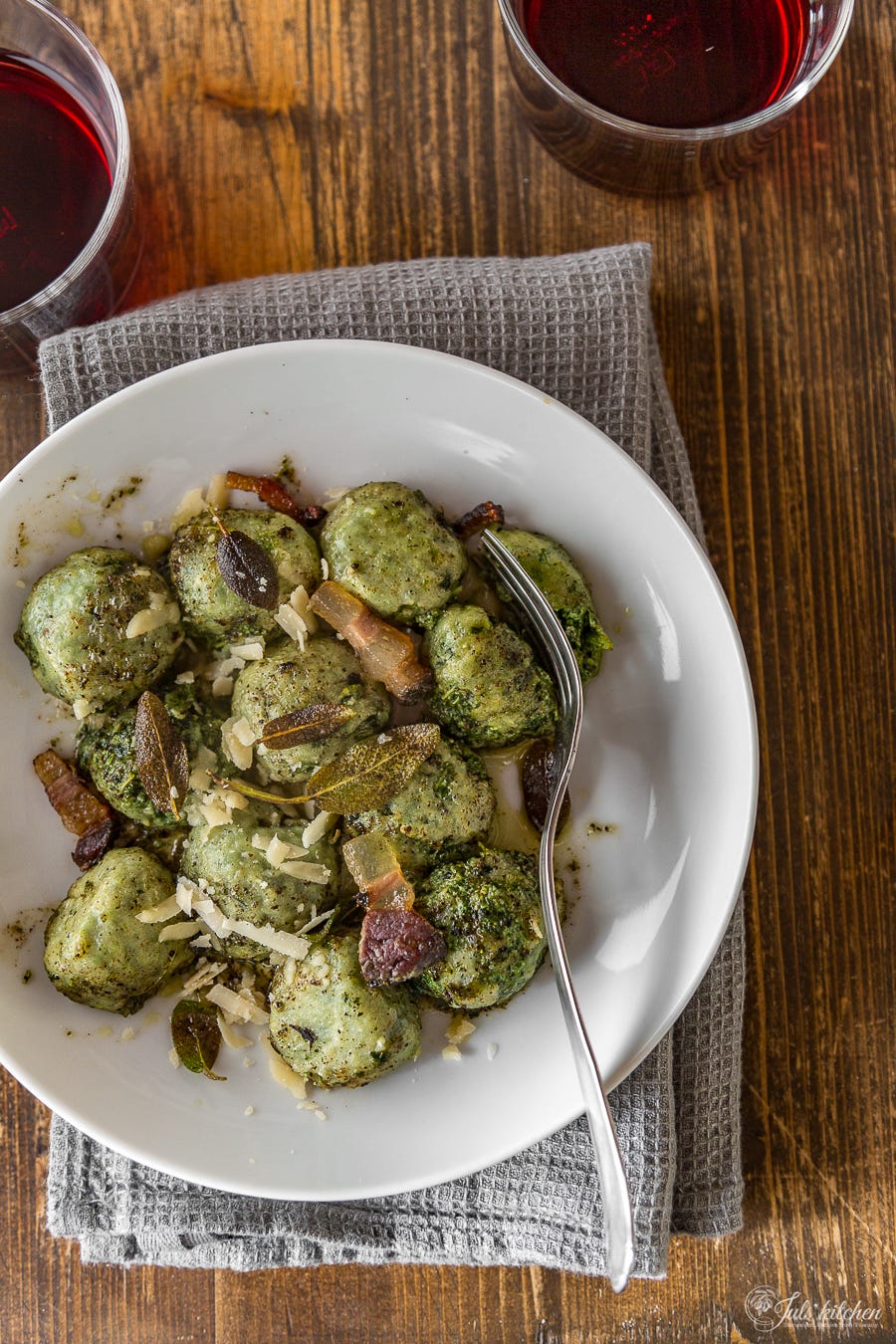
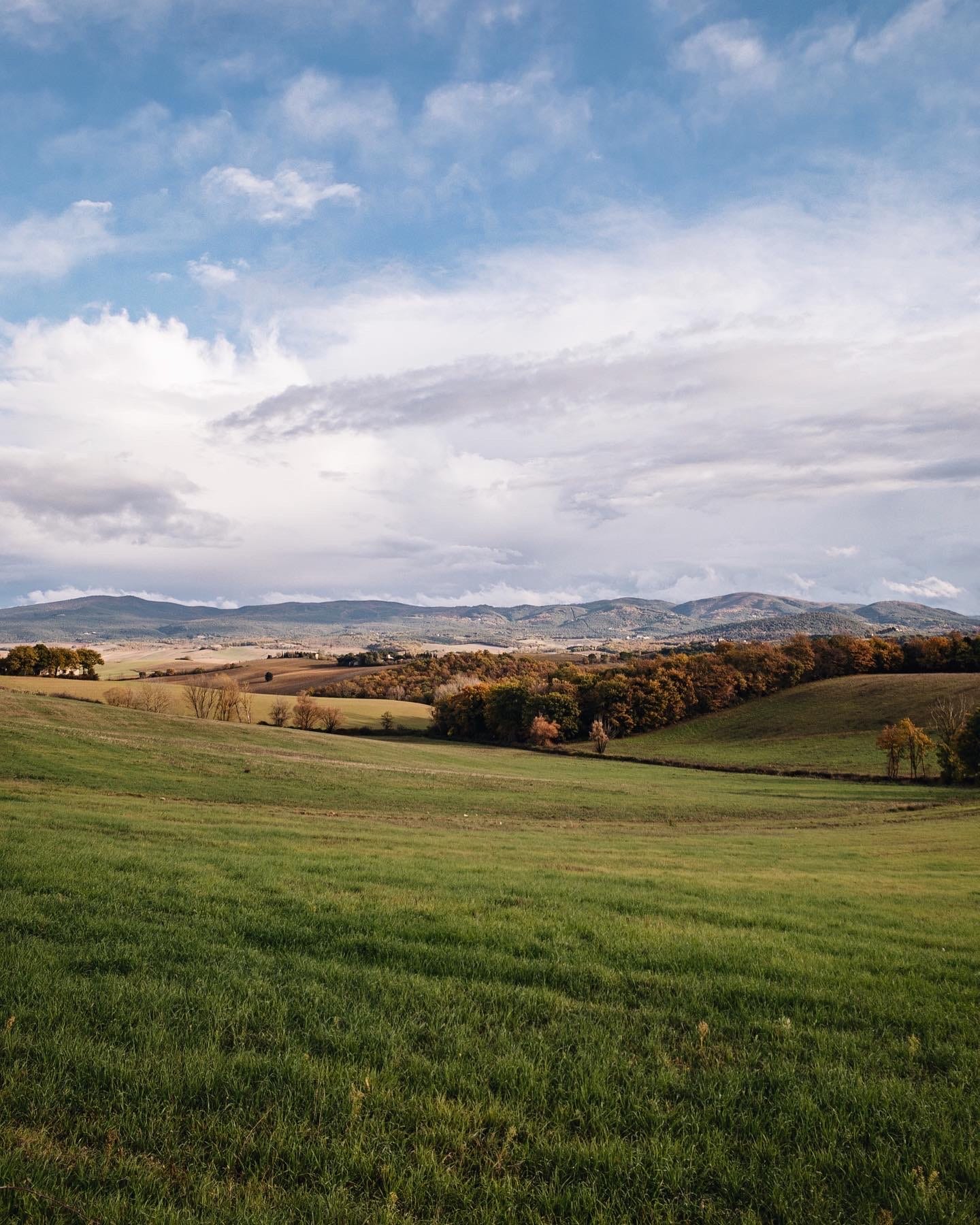
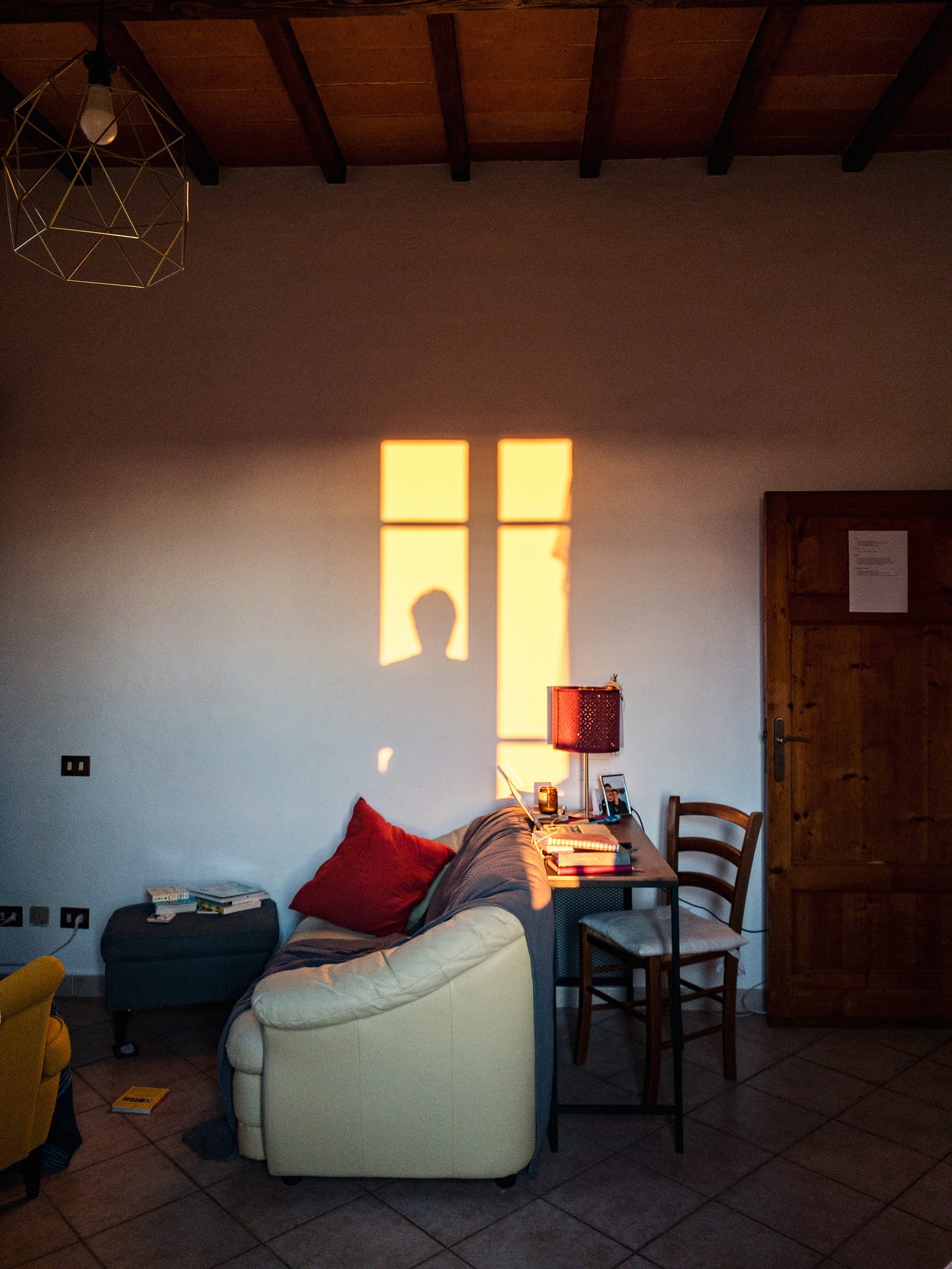

I love the new trend in newsletters. Second only to podcasts, it is my favorite way to get information and connect with people I wouldn’t otherwise know. I just don’t read blogs anymore because I’m usually on my phone and not a computer, and blogs are just harder to read on a phone! I will read blogs from a link in a newsletter, though. I also love that because of your podcast, I can “read” this newsletter in your voice!